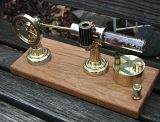- Joined
- Dec 13, 2009
- Messages
- 8
- Reaction score
- 0
OK, here goes. I'm new to the machining hobby & have just completed my first Lamina engine. I have been trying for 4 days now to get it to run, to no avail. I have tried different amounts of regenerator material and in different locations. Still nothing. I replaced the alum piston with one made from steel, still nodda.
Dimensions are as follows: test tube 15mm x 125mm, hole leading into the test tube is .22, Cyl - alum .749 ID 1.2 long, Piston - steel .747 OD .7 long, Stroke is approx .85, flywheel is 2.7" taken from a VCR & is part alum and steel, connect rod is brass, Escentric is alum 1", flywheel & escentric are mounted to a shaft spinning on a ball bearing from same VCR as flywheel was taken from.
I did notice that an engine built by Harrie IJzendoorn had closer tolerances to the piston/cyl then I do. But maybe I should go for more. Engine does have good compression. After turning the engine by hand for sometime, it wants to push the test tube off it's location (held in place by O rings). With test tube attached, there is some resistance felt due to compression(?). With test tube removed, assembly spins quite freely.
Attached are pics of assembled engine as well as exploded view. I guess I should have phrased that as a disassembled view.
Any advice and/or help would be appreciated. Gritz



Dimensions are as follows: test tube 15mm x 125mm, hole leading into the test tube is .22, Cyl - alum .749 ID 1.2 long, Piston - steel .747 OD .7 long, Stroke is approx .85, flywheel is 2.7" taken from a VCR & is part alum and steel, connect rod is brass, Escentric is alum 1", flywheel & escentric are mounted to a shaft spinning on a ball bearing from same VCR as flywheel was taken from.
I did notice that an engine built by Harrie IJzendoorn had closer tolerances to the piston/cyl then I do. But maybe I should go for more. Engine does have good compression. After turning the engine by hand for sometime, it wants to push the test tube off it's location (held in place by O rings). With test tube attached, there is some resistance felt due to compression(?). With test tube removed, assembly spins quite freely.
Attached are pics of assembled engine as well as exploded view. I guess I should have phrased that as a disassembled view.
Any advice and/or help would be appreciated. Gritz




































































